Related Research Articles

Okinawa Prefecture is a prefecture of Japan. Okinawa Prefecture is the southernmost and westernmost prefecture of Japan and has a population of 1,457,162 and a geographic area of 2,281 km2.
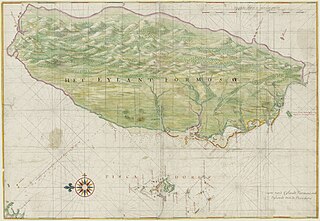
The history of the island of Taiwan dates back tens of thousands of years to the earliest known evidence of human habitation. The sudden appearance of a culture based on agriculture around 3000 BC is believed to reflect the arrival of the ancestors of today's Taiwanese indigenous peoples. Han Chinese gradually came into contact with Taiwan starting in the late 13th century and started settling there by the early 17th century. Named Formosa by Portuguese explorers, the south of the island was colonized by the Dutch in the 17th century whilst the Spanish built a settlement in the north which lasted until 1642. These European settlements were followed by an influx of Hoklo and Hakka immigrants from Fujian and Guangdong across the Taiwan Strait.

The Sakishima Islands are an archipelago located at the southernmost end of the Japanese Archipelago. They are part of the Ryukyu Islands and include the Miyako Islands and the Yaeyama Islands. The islands are administered as part of Okinawa Prefecture, Japan.

Gusuku often refers to castles or fortresses in the Ryukyu Islands that feature stone walls. However, the origin and essence of gusuku remain controversial. In the archaeology of Okinawa Prefecture, the Gusuku period refers to an archaeological epoch of the Okinawa Islands that follows the shell-mound period and precedes the Sanzan period, when most gusuku are thought to have been built. Many gusuku and related cultural remains on Okinawa Island have been listed by UNESCO as World Heritage Sites under the title Gusuku Sites and Related Properties of the Kingdom of Ryukyu.
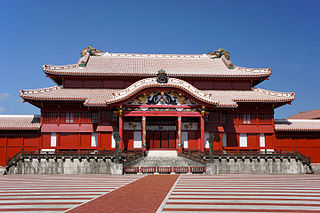
This article is about the history of the Ryukyu Islands southwest of the main islands of Japan.

Awamori is an alcoholic beverage indigenous and unique to Okinawa, Japan. It is made from long grain indica rice, and is not a direct product of brewing but of distillation. The majority of awamori made today uses indica rice imported from Thailand, as the local production is largely insufficient to meet domestic demand, which has risen considerably in recent years.

Liuqiu, also known by several other names, is a coral island in the Taiwan Strait about 13 kilometers (8 mi) southwest of the main island of Taiwan. It has an area of 6.8 km2 (2.6 sq mi) and approximately 13,000 residents, the vast majority of whom share only 10 surnames. It is administered as a township of Pingtung County in Taiwan Province, Republic of China. As of 2019 the township chief is Chen Lung-chin.

The Ryukyu Islands, also known as the Nansei Islands or the Ryukyu Arc, are a chain of Japanese islands that stretch southwest from Kyushu to Taiwan: the Ōsumi, Tokara, Amami, Okinawa, and Sakishima Islands, with Yonaguni the westernmost. The larger are mostly volcanic islands and the smaller mostly coral. The largest is Okinawa Island.
Shō Hashi was the last King of Chūzan and the first king of the Ryukyu Kingdom, uniting the three polities of Chūzan, Hokuzan, and Nanzan by conquest and ending the Sanzan period.

Kikaijima is one of the Satsunan Islands, classed with the Amami archipelago between Kyūshū and Okinawa.
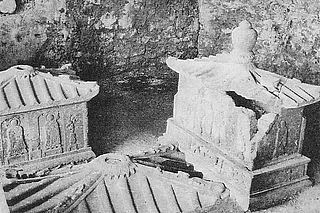
Eiso was a semi-legendary ruler of Okinawa Island. He was the founding monarch of the Eiso dynasty.
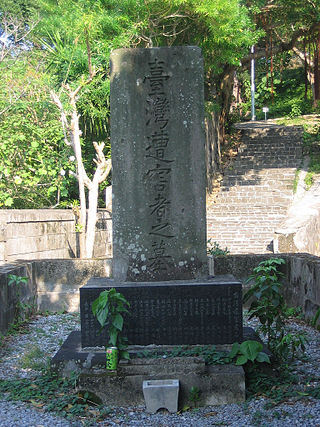
The Mudan incident of 1871 was the massacre of 54 Ryukyuan sailors in Qing-era Taiwan who wandered into the central part of Taiwan after their ship shipwrecked off of Taiwan's southeastern coast.
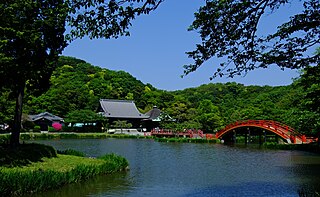
A map of Japan currently stored at Kanazawa Bunko depicts Japan and surrounding countries, both real and imaginary. The date of creation is unknown but probably falls within the Kamakura period. It is one of the oldest surviving Gyōki-type maps of Japan. It reveals Japan's self-image and the understanding of neighboring countries after the Mongol invasions of 1274 and 1281
Kamuiyaki ware (カムィヤキ), from Tokunoshima kamïyaki, is grey stoneware produced in Tokunoshima, the Amami Islands, Kagoshima Prefecture, Japan from the 11th century to the early 14th century, or from the late Heian period to the Kamakura period.

The Second Shō dynasty was the last dynasty of the Ryukyu Kingdom from 1469 to 1879, ruled by the Second Shō family under the title of King of Chūzan. This family took the family name from the earlier rulers of the kingdom, the first Shō family, even though the new royal family has no blood relation to the previous one. Until the abolition of Japanese peerage in 1947, the head of the family was given the rank of marquess while several cadet branches held the title of baron.

The First Shō dynasty was a dynasty of the Ryukyu Kingdom on Okinawa Island in the 15th century, ruled by the First Shō family under the title of King of Chūzan. According to the official history books compiled during the second Shō Dynasty, it lasted from 1406 to 1469. However, the official account is considered unreliable by modern historians because it contradicts contemporary sources.
Liuqiu or Lewchew is a Chinese place-name variously denoting:
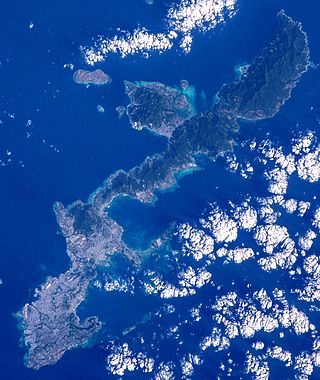
Okinawa (沖縄) is a name with multiple referents. The endonym [x[Prototype theory|prototypically]] refers to Okinawa Island in southwestern Japan. Today it can cover some surrounding islands and, more importantly, can refer to Okinawa Prefecture, a much larger administrative division of Japan, although the people from the Miyako and Yaeyama Islands still feel a strong sense of otherness to Okinawa.
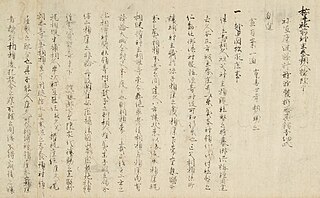
The Hyōtō Ryūkyū-koku ki (漂到流球国記) was a book written by Japanese Buddhist monk Keisei in 1244. He interviewed travelers who, during a sea voyage to Song China, drifted to what they believed to be Ryūkyū. It reflects the long-lasting Japanese perception of Ryūkyū as the land of man-eating demons.
Wakoku was the name used by early imperial China and its neighbouring states to refer to the nation usually identified as Japan. There are various theories regarding the extent of power of the early kings of Japan. According to the Book of Sui and the History of the Northern Dynasties, its borders were five months from east to west and three months from north to south. The Wajin appear in historical documents such as the Book of Han and the Geographical Survey of Japan from around the 2nd century BC. In the late 7th century, the Yamato kingdom, which had been called Yamato, changed its external name to Japan, but its relation to Japan since Book of the Later Han is not clear. There are discrepancies in the descriptions of the Old Book of Tang and the New Book of Tang.
References
- ↑ Beillevaire, Patrick (2000). 西洋の出会った大琉球 (Ryukyu Studies to 1854: Western Encounter Part 1). Richmond, Surrey: Curzon Press. p. 120. ISBN 0-7007-1356-5.
- ↑ Nolan, Peter (2015-03-01). Re-balancing China: Essays on the Global Financial Crisis, Industrial Policy and International Relations. London: Anthem Press. p. 188. ISBN 978-1-78308-126-4.
- ↑ Wei Zheng (636). "流求國". Book of Sui (in Chinese). Vol. 81.
- ↑ Chang, Bi-yu (2015). Place, Identity, and National Imagination in Post-war Taiwan. Abingdon & New York: Routledge. p. 64, n. 19.
- ↑ "Ancient Ryukyu - Contents". ryukyu-okinawa.net. Retrieved 2020-06-19.
- ↑ Thompson, Lawrence G. (1964). "The earliest eyewitness accounts of the Formosan aborigines". Monumenta Serica. 23: 163–204. doi:10.1080/02549948.1964.11731044. JSTOR 40726116.
- 1 2 Tadayoshi, Murata (2016-06-17). Origins Of Japanese-chinese Territorial Dispute, The: Using Historical Records To Study The Diaoyu/senkaku Islands Issue. Hackensack, NJ: World Scientific. pp. 58, 59. ISBN 978-981-4749-10-7.
- ↑ Kerr, George (1958), Okinawa: History of an Island People, Tokyo: Charles E. Tuttle, p. 90, ISBN 978-0-8048-2087-5
- ↑ Tanaka Fumio 田中史生 (2008). "Kodai no Amami Okinawa shotō to kokusai shakai" 古代の奄美・沖縄諸島と国際社会. In Ikeda Yoshifumi (ed.). Kodai chūsei no kyōkai ryōiki古代中世の境界領域. pp. 49–70.
- ↑ Tai, Michael (2019-09-15). China and Her Neighbours: Asian Diplomacy from Ancient History to the Present. Zed Books Ltd. ISBN 978-1-78699-779-1.